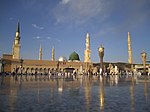Related Research Articles

Muhammad ibn Abdullah was an Arab religious, social, and political leader and the founder of the world religion of Islam. According to Islamic doctrine, he was a prophet, divinely inspired to preach and confirm the monotheistic teachings of Adam, Abraham, Moses, Jesus, and other prophets. He is believed to be the final prophet of God in all the main branches of Islam, though the modern Ahmadiyya movement diverges from this belief. Muhammad united Arabia into a single Muslim polity, with the Quran as well as his teachings and practices forming the basis of Islamic religious belief.

The Quraysh were a grouping of Arab clans that historically inhabited and controlled the city of Mecca and its Ka'ba. The Islamic prophet Muhammad was born into the Hashim clan of the tribe. Despite this, many of the Quraysh staunchly opposed Muhammad, until converting to Islam en masse in c. 630 CE. Afterwards, leadership of the Muslim community traditionally passed to a member of the Quraysh, as was the case with the Rashidun, Umayyad, Abbasid and purportedly, the Fatimid caliphates.

The Banū Hāshim is the clan of the Quraysh tribe to which the prophet Muhammad belonged, named after Muhammad's great-grandfather Hashim ibn Abd Manaf.
Banu Abd Shams refers to a clan within the Meccan tribe of Quraysh.
ʿAbd al-ʿUzzā ibn ʿAbd al-Muṭṭalib , often known as Abū Lahab was Muhammad's half paternal uncle. He was one of the Meccan Quraysh leaders who opposed Muhammad and his followers and was condemned in the surah Lahab of the Quran for antagonizing Islam.

Banū Taym was one of the major and wealthiest clans of the Quraysh. They are regarded as one of the most influential clans in Mecca, after the advent of Islam. In traditional sources, the clan is believed to be descended Taym ibn Murrah.
Al-Mughira ibn Abd Allah ibn Umar was a preeminent leader of the Quraysh tribe's Banu Makhzum clan in Mecca in the 6th century. His descendants, the Banu al-Mughira, became the principle house of the Makhzum for the remainder of the pre-Islamic period and in the centuries following the advent of Islam in the 620s.

Shayba ibn Hashim, better known as Abd al-Muttalib, was the fourth chief of the Quraysh tribal confederation. He was the grandfather of the Islamic prophet Muhammad.
The Banu Makhzum was one of the wealthy clans of the Quraysh. They are regarded as being among the three most powerful and influential clans in Mecca before the advent of Islam, the other two being the Banu Hashim and the Banu Umayya.

Muhammad, the final Islamic prophet, was born and lived in Mecca for the first 53 years of his life until the Hijra. This period of his life is characterized by his proclamation of prophethood. Muhammad's father, Abdullah ibn Abd al-Muttalib, died before he was born. His mother would raise him until he was 6 years old, before her death around 577 CE at Abwa'. Subsequently raised by his grandfather, Abd al-Muttalib, and then his uncle, Abu Talib ibn ‘Abd al-Muttalib, Muhammad's early career involved being a shepherd and merchant. Muhammad married Khadija bint Khuwaylid after a successful trading endeavour in Syria. After the death of Khadija and Abu Talib in the Year of Sorrow, Muhammad married Sawda bint Zam'a and Aisha.

In the early days of Islam at Mecca, the new Muslims were often subjected to abuse and persecution. The persecution lasted for 12 years beginning from the advent of Islam to Hegira. Muhammad preached Islam secretly for 3 years. Then, he openly preached Islam, resulting in public prosecutions to take place, and even more dreadfully. Muhammad and his followers were first belittled and ridiculed, then persecuted and physically attacked for departing from traditional Mecca's tribal ways.
The Ansar were the local inhabitants of Medina who, in Islamic tradition, took the Islamic prophet Muhammad and his followers into their homes when they emigrated from Mecca during the hijra.

Abu Talib ibn Abd al-Muttalib Abu Talib means; The father of Talib, born ʿImrān (عِمْرَان) or ʿAbd Manāf, was the leader of Banu Hashim, a clan of the Qurayshi tribe of Mecca in the Hejazi region of the Arabian Peninsula. He was an uncle of the Islamic prophet Muhammad, and father of the Rashidun Caliph Ali. After the death of his father Abd al-Muttalib ibn Hashim ibn Abd Manaf, he inherited this position, and the offices of Siqaya and Rifada. He was well-respected in Mecca, despite a declining fortune.
Sakhr ibn Harb ibn Umayya ibn Abd Shams, better known by his kunyaAbu Sufyan, was a prominent opponent turned companion of the Islamic prophet Muhammad. He was the father of Mu'awiya I and thus the forefather of all the Ummayid Caliphs. One of Abu Sufyan's daughters, Ramlah, was married to Muhammad, but this happened before Abu Sufyan's conversion and without his consent.
The Mushrikun was an Arabian polytheistic sect which opposed Muhammad and his Muslims in the early 7th century. They were strict worshippers of idolatry who had denounced the spread of monotheism in Arabia. Their leaders were mostly from the Quraysh, but others also belonged to the Qays.

The Umayyad dynasty or Umayyads were the ruling family of the Muslim caliphate between 661 and 750 and later of Islamic Iberia in southwestern Europe between 756 and 1031. In the pre-Islamic period, they were a prominent clan of the Meccan tribe of Quraysh, descended from Umayya ibn Abd Shams. Despite staunch opposition to the Islamic prophet Muhammad, the Umayyads embraced Islam before the latter's death in 632. A member of the clan, Uthman, went on to become the third Rashidun caliph in 644–656, while other members held various governorships. One of these governors, Mu'awiya I, fought the First Muslim Civil War in 661 and established the Umayyad Caliphate with its capital in Damascus, Syria. This marked the beginning of the Umayyad dynasty, the first hereditary dynasty in the history of Islam, and the only one to rule over the entire Islamic world of its time.
Laylat al-Mabīt refers to the night in which the Islamic prophet Muhammad left Mecca for Yathrib, a city that would later be renamed Medina in his honor. Forced by the prosecution of Meccan disbelievers, Muhammad's flight took place on the first night of Rabi' al-awwal in 622 CE. The term Laylat al-Mabit is often associated in the Islamic literature with the accounts about Muhammad's cousin, Ali, who risked his life for Muhammad's safe escape.
Al-Hashimi, also transliterated Al-Hashemi, Hashemi, Hashimi or Hashmi is an Arabic, Arabian, and Persian surname. The definite article Al- usually distinguishes the Arabic from the more numerous form.
The Hashemite–Umayyad rivalry was a feud between the clans of Banu Hashim and Banu Umayya, both belonging to the Meccan Arab tribe of Quraysh, in the 7th and 8th centuries. The rivalry is important as it influenced key events in the course of early Islamic history.
References
- ↑ Francis E. Peters, The Monotheists: Jews, Christians, and Muslims in Conflict and Competition, p.96
- 1 2 Moojan Momen, An Introduction to Shi'i Islam: The History and Doctrines of Twelver Shiʻism, Yale University Press, p.4
- ↑ Francis E. Peters, Mecca: A Literary History of the Muslim Holy Land, Princeton University Press, 1994, ISBN 0-691-03267-X, p.54
- ↑ Daniel W. Brown,A New Introduction to Islam, Blackwell Publishing, p.76, 2004, ISBN 0-631-21604-9
- ↑ "Answering-Ansar.org :: Our 20 questions". Archived from the original on 2006-08-24. Retrieved 2006-07-25.
- ↑ taken from Siratun Nabi by Shibli Numani Vol 1 p 218, English translation by M. Tayyib Bakhsh Budayuni Archived 2006-08-24 at the Wayback Machine
- ↑ www.islam4theworld.com
- ↑ Taken from Tarikh al-Tabari, Volume 6 page 81 - Muhammad at Mecca (book), translated by William Montgomery Watt & M.V. MacDonald Archived 2006-08-24 at the Wayback Machine

